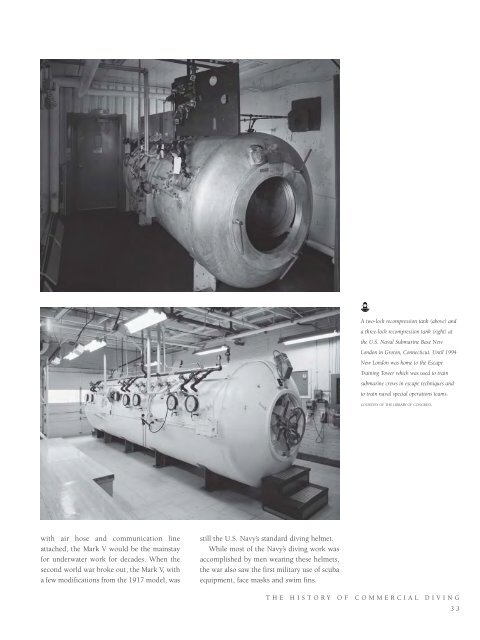Working Underwater: The Story of the Commercial Diving Industry
An illustrated history of the commercial diving industry paired with the histories of companies that have helped shape the industry.
An illustrated history of the commercial diving industry paired with the histories of companies that have helped shape the industry.
You also want an ePaper? Increase the reach of your titles
YUMPU automatically turns print PDFs into web optimized ePapers that Google loves.
A two-lock recompression tank (above) and<br />
a three-lock recompression tank (right) at<br />
<strong>the</strong> U.S. Naval Submarine Base New<br />
London in Groton, Connecticut. Until 1994<br />
New London was home to <strong>the</strong> Escape<br />
Training Tower which was used to train<br />
submarine crews in escape techniques and<br />
to train naval special operations teams.<br />
COURTESY OF THE LIBRARY OF CONGRESS.<br />
with air hose and communication line<br />
attached, <strong>the</strong> Mark V would be <strong>the</strong> mainstay<br />
for underwater work for decades. When <strong>the</strong><br />
second world war broke out, <strong>the</strong> Mark V, with<br />
a few modifications from <strong>the</strong> 1917 model, was<br />
still <strong>the</strong> U.S. Navy’s standard diving helmet.<br />
While most <strong>of</strong> <strong>the</strong> Navy’s diving work was<br />
accomplished by men wearing <strong>the</strong>se helmets,<br />
<strong>the</strong> war also saw <strong>the</strong> first military use <strong>of</strong> scuba<br />
equipment, face masks and swim fins.<br />
THE HISTORY OF COMMERCIAL DIVING<br />
33
















